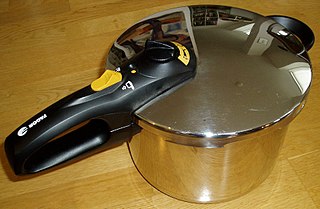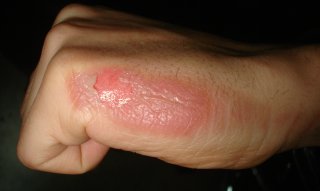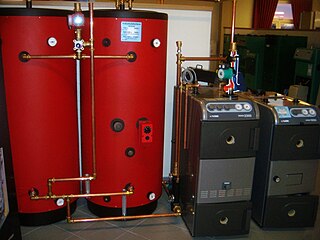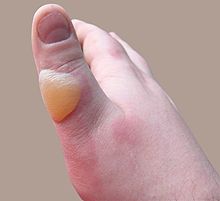
A bain-marie, also known as a water bath or double boiler, a type of heated bath, is a piece of equipment used in science, industry, and cooking to heat materials gently or to keep materials warm over a period of time. A bain-marie is also used to melt ingredients for cooking.

Cooking, also known as cookery or professionally as the culinary arts, is the art, science and craft of using heat to make food more palatable, digestible, nutritious, or safe. Cooking techniques and ingredients vary widely, from grilling food over an open fire, to using electric stoves, to baking in various types of ovens, reflecting local conditions. Cooking is an aspect of all human societies and a cultural universal.

The Fahrenheit scale is a temperature scale based on one proposed in 1724 by the European physicist Daniel Gabriel Fahrenheit (1686–1736). It uses the degree Fahrenheit as the unit. Several accounts of how he originally defined his scale exist, but the original paper suggests the lower defining point, 0 °F, was established as the freezing temperature of a solution of brine made from a mixture of water, ice, and ammonium chloride. The other limit established was his best estimate of the average human body temperature, originally set at 90 °F, then 96 °F.

A pressure cooker is a sealed vessel for cooking food with the use of high pressure steam and water or a water-based liquid, a process called pressure cooking. The high pressure limits boiling and creates higher temperatures not possible at lower pressures, allowing food to be cooked faster than at normal pressure.

A boiler is a closed vessel in which fluid is heated. The fluid does not necessarily boil. The heated or vaporized fluid exits the boiler for use in various processes or heating applications, including water heating, central heating, boiler-based power generation, cooking, and sanitation.
Liebeck v. McDonald's Restaurants, also known as the McDonald's coffee case and the hot coffee lawsuit, was a highly publicized 1994 product liability lawsuit in the United States against the McDonald's restaurant chain.

A burn is an injury to skin, or other tissues, caused by heat, cold, electricity, chemicals, friction, or ionizing radiation. Most burns are due to heat from hot liquids, solids, or fire. Burns occur mainly in the home or the workplace. In the home, risks are associated with domestic kitchens, including stoves, flames, and hot liquids. In the workplace, risks are associated with fire and chemical and electric burns. Alcoholism and smoking are other risk factors. Burns can also occur as a result of self-harm or violence between people (assault).

Water heating is a heat transfer process that uses an energy source to heat water above its initial temperature. Typical domestic uses of hot water include cooking, cleaning, bathing, and space heating. In industry, hot water and water heated to steam have many uses.

Sous vide, also known as low-temperature, long-time (LTLT) cooking, is a method of cooking invented by the French chef Georges Pralus in 1974, in which food is placed in a plastic pouch or a glass jar and cooked in a water bath for longer than usual cooking times at a precisely regulated temperature.

The following outline is provided as an overview of and topical guide to the preparation of food:

Boiled eggs are typically from a chicken, and are cooked with their shells unbroken, usually by immersion in boiling water. Hard-boiled or hard-cooked eggs are cooked so that the egg white and egg yolk both solidify, while soft-boiled eggs may leave the yolk, and sometimes the white, at least partially liquid and raw. Boiled eggs are a popular breakfast food around the world.

Microfoam is finely textured milk used for making espresso-based coffee drinks, particularly those with latte art. It is typically made with the steam wand of an espresso machine, which pumps steam into a pitcher of milk.
Scalded milk is dairy milk that has been heated to 83 °C (181 °F). At this temperature, bacteria are killed, enzymes in the milk are destroyed, and many of the proteins are denatured. Since most milk sold today is pasteurized, which accomplishes the first two goals, milk is typically scalded to increase its temperature, or to change the consistency or other cooking interactions by the denaturing of proteins.
Low-temperature cooking is a cooking technique that uses temperatures in the range of about 60 to 90 °C for a prolonged time to cook food. Low-temperature cooking methods include sous vide cooking, slow cooking using a slow cooker, cooking in a normal oven which has a minimal setting of about 70 °C (158 °F), and using a combi steamer providing exact temperature control. The traditional cooking pit also cooks food at low temperature.

A thermostatic mixing valve (TMV) is a valve that blends hot water with cold water to ensure constant, safe shower and bath outlet temperatures to prevent scalding.
A thermal burn is a type of burn resulting from making contact with heated objects, such as boiling water, steam, hot cooking oil, fire, and hot objects. Scalds are the most common type of thermal burn suffered by children, but for adults thermal burns are most commonly caused by fire. Burns are generally classified from first degree up to fourth degree, but the American Burn Association (ABA) has categorized thermal burns as minor, moderate, and major, based almost solely on the depth and size of the burn.
Protein adsorption refers to the adhesion of proteins to solid surfaces. This phenomenon is an important issue in the food processing industry, particularly in milk processing and wine and beer making. Excessive adsorption, or protein fouling, can lead to health and sanitation issues, as the adsorbed protein is very difficult to clean and can harbor bacteria, as is the case in biofilms. Product quality can be adversely affected if the adsorbed material interferes with processing steps, like pasteurization. However, in some cases protein adsorption is used to improve food quality, as is the case in fining of wines.

A hot water storage tank is a water tank used for storing hot water for space heating or domestic use.

Sour cream is a dairy product obtained by fermenting regular cream with certain kinds of lactic acid bacteria. The bacterial culture, which is introduced either deliberately or naturally, sours and thickens the cream. Its name comes from the production of lactic acid by bacterial fermentation, which is called souring. Crème fraîche is one type of sour cream with a high fat content and less sour taste.

Foodborne illness is any illness resulting from the food spoilage of contaminated food, pathogenic bacteria, viruses, or parasites that contaminate food. Infant food safety is the identification of risky food handling practices and the prevention of illness in infants. Foodborne illness is a serious health issue, especially for babies and children. Infants and young children are particularly vulnerable to foodborne illness because their immune systems are not developed enough to fight off foodborne bacterial infections. In fact, 800,000 illnesses affect children under the age of 10 in the U.S. each year. Therefore, extra care should be taken when handling and preparing their food.















